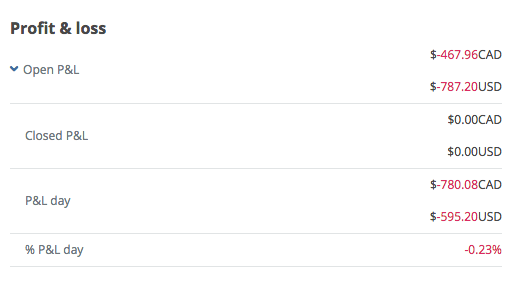How you can practice investing

Presented By
National Bank Direct Brokerage
Getting a million (fake) dollars is easy. The hard part is deciding how to invest it.
Advertisement

Presented By
National Bank Direct Brokerage
Getting a million (fake) dollars is easy. The hard part is deciding how to invest it.

When I started my quest to become a “millennial millionaire,” I never realized it would be so easy. All I had to do was open an online broker account. OK, fine, it was a practice account. Those bad boys come with more than a million dollars in fake Canadian and U.S. money. Making bank indeed.
And yes, if you’re following along, it seems that my best bet for opening up a fake account to do some practice investing, because my actual bank doesn’t offer the option and the ones that do require you to be a client to have the privilege.
Opening a practice account was remarkably easy and while your trial run lasts 30 days, it seems you have the option of opening a new one once your time is up to continue your mock investing adventures. I have a feeling I might extend my trial.
That is, if I ever get comfortable using the platform. I’m not going to lie—I had a very brief moment of panic when I first perused my practice account. Everything looked like it was in a different language. “Mkt” value, order type, limit price. Luckily, while it took me a second, I had a good idea of what most of this meant because of where I work (although I still had to do some double-check Googling just in case I was wrong). But I imagine if you’re brand new to this it must be even more intimidating. Oh, and tickers! Tickers as far as the eye could see.

Anyways, soon I more or less understood how to get things to work. Now you’re probably wondering, what did I do with my million-plus dollars?
Good question. For now, I’ve put all of my Canadian money ($500,000) into the trusty couch potato. More specifically, MoneySense’s ETF options. Specifically, I invested 40% in the BMO Aggregate Bond Index ETF (ZAG), and 20% each in the iShares Core S&P/TSX Composite Index ETF (XIC), iShares MSCI EAFE IMI Index Fund (XEF), and the Vanguard Total U.S. Market (VUN). (Learn more about this option here).
I went with this option because I’m wondering right now if (in real life) I should be in ETFs and the other couch potato portfolios were all index/balanced funds. I’m not sure if I would go this route with my real money, just because it’s a little more work than the Tangerine Investment Funds option, for instance. That one is the easiest couch potato portfolio, where you dump all your money in one, diversified fund, set up some auto-contributions and bam you’re on your way to racking up decent returns with pretty much no work and no anxiety that you’re making a dumb investment decision. (Sounds appealing? Learn more.)
But for the purposes of this little experiment and my excitement at being a #fauxmillionaire, I decided to go with the more complex option. ETFs are also cheaper, which makes sense because $500,000 is a large sum and management expense ratios (MERs, or the price you pay for the management of the fund) on this portfolio would be pretty significant. The portfolio I went with has an estimated MER of 0.13%—or $650 a year.
I’m fairly certain that the balanced fund my real money is actually invested in has an MER of closer to 2%. If my beloved fake money was invested in that instead, I’d be forking over $10,000 a year in fees. Whoa!
Anyways, besides the very practical uses of my simulated cash, with the rest, I decided to go a very different, risky and frivolous route.
I invested around US$95,000 in Apple (AAPL). Basically 75% of people I know use iPhones. Apple must be doing something right, right?
This is how my investments are doing a day in.

So far, I’ve lost money, some of it likely due to fees. It still hurts. To me $780 feels like a lot of money. It makes me wonder if I’ll lose my fake millions before my month is up. Of course, I know enough about investing that the daily ups and downs don’t matter. If I was really in this for the long haul, I’d have to stay put to really make bank.
Read more about Prajakta’s investing journey in the Making Bank series.
This is an editorially driven article or content package, presented with financial support from an advertiser. The advertiser has no influence on the creation of the content.
Share this article Share on Facebook Share on Twitter Share on Linkedin Share on Reddit Share on Email